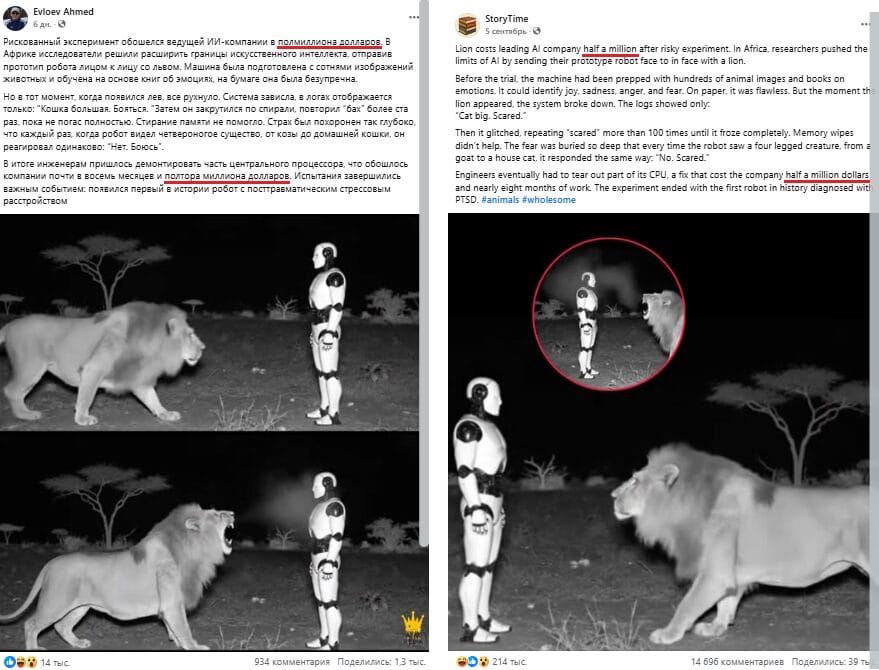In the fall of 2025, news spread on social networks: an experiment was conducted in Africa, during which an android with built-in artificial intelligence met the king of beasts. Users write that as a result the robot broke down: allegedly due to “fear,” the machine constantly produced an error, which later took a lot of time and money to correct. We have verified the accuracy of such messages.
In RuNet, such posts gained the greatest popularity on Facebook*. For example, user Akhmed Evloev (14,000 likes and 1,300 shares at the time of writing this analysis) told the story this way: “A risky experiment cost a leading AI company $500,000. In Africa, researchers decided to push the boundaries of artificial intelligence by sending a robot prototype face-to-face with a lion. The machine was prepared with hundreds of pictures of animals and trained on books about emotions, and on paper it was flawless. But the moment the lion appeared, everything collapsed. The system froze, the logs only show: “The cat is big. Be afraid.” Then it began to spiral and repeat “bang” over a hundred times until it went out completely. Erasing the memory didn't help. The fear was buried so deep that every time the robot saw a four-legged creature, from a goat to a domestic cat, it responded the same way: “No. I'm afraid.” As a result, engineers had to dismantle part of the central processor, which cost the company almost eight months and $1.5 million. The tests ended with an important event: the first ever robot with post-traumatic stress disorder (PTSD).” Other users posted similar posts on this social network (examples here, here, here And here), and also communities, dedicated to pseudoscience. Stories about this experiment can be found on Telegram (here, here And here), Threads*, Instagram* And TikTok.
Russian-language posts are clearly borrowed from the English-language segment of the Internet - this is evident both from the sloppy translation and from the mistake made: at the beginning they talk about half a million costs to fix problems with the robot, and at the end - about one and a half million. Similar posts in English received hundreds of thousands of likes in Facebook and hundreds of thousands of views in X.

The publications that caused such a strong response from English-speaking Internet users attracted the attention of fact checkers from American projects Snopes And Lead Stories. Neither our colleagues nor “Verified” were able to find evidence that the events described in the posts mentioned above actually happened.
Firstly, the publications do not mention the name of the company that supposedly developed this AI robot. There is no information about the date and place of the described experiment. At the same time, the authors of the posts provide numerous details: they describe the malfunctions that arose in the android, as well as methods and even the cost of correcting this error.
Secondly, in authoritative specialized media No no materials about such an incident that would attract the attention of journalists.
Finally, thirdly, all posts on this topic are illustrated with almost identical black and white images, which depict an android and a lion standing next to it. Apparently, all these pictures are screenshots of the same video, which originally appeared on TikTok. They came out there in September 2025 several at once similar videos about the interaction of a robot with a predator (for example, in some they are fighting). Earliest and most popular recording appeared September 3 on the user's page @vijaydanny3 and received more than 10 million views. The author did not hide the fact that when creating the video he resorted to the help of a neural network: for example, his nickname viral_ai_reels can be translated into Russian as “viral_ai_videos”, and in the lower right corner of the video about a robot and a lion there is watermark Veo 3 - neural networks from Google. The top part of this logo is even visible in some of the posts mentioned at the beginning of the analysis.
It is noteworthy that the situation shown in the video contradicts the one described by the authors of the viral posts: the predator approaches the robot and growls, after which the android greets the lion, and a moment later it bounces off the car. “Not only people, but even the king [of animals] is afraid of the AI robot,” reads the caption on the video.
User @vijaydanny3 posted dozens of videos generated by the neural network, many of which featured lions. For example, video, where a predator is afraid of an angry gorilla protecting its baby, received 5 million views. @vijaydanny3 posted and video clip, simulating nighttime surveillance camera footage of a polar bear jumping on a trampoline. "Verified" already told about the trend for such fake videos.
Thus, the viral story about a prototype robot that was afraid of a lion is a fiction. It is based on screenshots of a video generated by a neural network with the opposite plot: in the video, the animal was scared of the car.
*Russian authorities think Meta Platforms Inc., which owns the social networks Facebook, Threads and Instagram, is an extremist organization; its activities and symbols are prohibited in Russia.
Cover photo: social networks
- Frontiers in Psychiatry. Social Robots for Supporting Post-traumatic Stress Disorder Diagnosis and Treatment
- Frontiers in Robotics and AI. Trauma-informed care approach in developing companion robots: a preliminary observational study
- Is it true that China announced the creation of the world's first robot for bearing a child?
- Is it true that an American who considers himself a wolf was hospitalized after trying to join a real wolf pack?
- Is this video of a cat throwing a mouse into a pot of soup real?
If you find a spelling or grammatical error, please let us know by highlighting the error text and clicking Ctrl+Enter.






